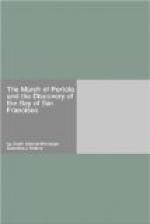During the absence of the explorers, the people of the expedition were compelled for want of meat to eat oak acorns, which caused them much suffering from indigestion and fever.
Portola called a council of officers, on November 11th, to determine the best course to pursue. The decision was unanimous to return to the Point of Pines and renew the search for the elusive Puerto de Monterey, which they believed they had left behind. This was at once acted upon, and the command took up the march in the afternoon of that day, returning by the route of its coming, and on the 27th camped in sight of the Point of Pines at a little lake of muddy water. They had partly subsisted on wild geese which they shot, and on mussels gathered from the rocks of the coast. The following day, November 28th, they moved across the Point of Pines and camped in the canada of the Carmelo, where was plenty of wood and good water from the river. After giving his men a rest, the governor sent ten soldiers, under command of Rivera, with six of the Indian pioneers, who undertook to guide them by the coast trails, with instructions to thoroughly explore the coast to the south and see if the Port of Monterey was concealed in some “rincon” of the Sierra de Santa Lucia.
The exploring party returned on Monday, December 4th, at night. They were tired out with their travels over the rough mountain trails, and they reported that no port of Monterey existed south of their camp; that the mountains belonged to the Sierra de Santa Lucia, and that there was no passage along the shore.
Vizcaino had said that Monterey was just north of the Sierra de Santa Lucia. “It is all that can be desired for commodiousness and as a station for ships making the voyage to the Philippines, sailing whence they make a landfall on this coast. This port is sheltered from all winds * * * and is thickly settled with people, whom I found to be of gentle disposition, peaceable, and docile; * * * they have flax like that of Castile, and hemp, and cotton,"[36] etc.
The commander knew not what to think. What should be a great port, protected from all winds, was but an ensenada; what should be the Rio Carmelo was but an arroyo; what should be great lakes were but lagunillas; “and where, too, were the people, so intelligent and docile, who raised flax and hemp and cotton?” Costanso says that in their entire journey, they found no country so thinly populated, nor any people more wild and savage than the few natives whom they met here. It is not strange that Portola failed to recognize, in the broad ensenada, Vizcaino’s Famoso Puerte de Monterey.




